14.1: The Challenges of Change
- Page ID
- 158812
STRESS AND HOMEOSTASIS
Condition of optimal functioning for an organism.
Any stimulus resulting in an imbalance in an organism’s homeostatic balance.
Ability of one genotype to produce more than one phenotype dependent on environmental conditions.
Multiple discrete phenotypes from an organism’s genotype in response to the environment; a special form of phenotypic plasticity.
An alteration in population-level gene frequencies related to environmentally induced selective pressures; leads to a greater level of fitness for a population related to a specific environment.
ADJUSTMENTS
The term “adjustment” refers to an organism’s non-genetic way of coping with the stressors of its environment. Although adjustments themselves are non-genetic in nature, the ability of an organism to experience or develop an adjustment is based in its phenotypic plasticity, which is linked to its evolutionarily guided genetic potential. Adjustments occur exclusively on the individual level. As such, different individuals within a population may experience a wide range of possible adjustments in response to a similar stressor. In general, the three main forms of adjustment are: behavioral, acclimatory, and developmental.
Non-genetic-based ways in which organisms adjust to environmental stressors.
Behavioral Adjustments
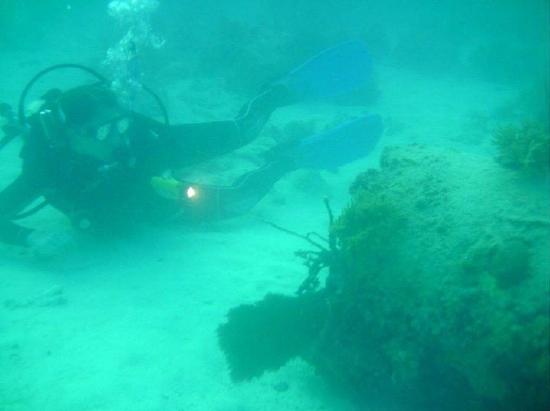 Figure \(\PageIndex{1}\): Notice the lack of full spectrum color in this photo of a deep-water diver and the diver’s use of specialized equipment, such as a breathing apparatus to deliver gases for respiration, bodysuit to ensure thermal regulation, and flashlight to increase visibility in the low-light setting.
Figure \(\PageIndex{1}\): Notice the lack of full spectrum color in this photo of a deep-water diver and the diver’s use of specialized equipment, such as a breathing apparatus to deliver gases for respiration, bodysuit to ensure thermal regulation, and flashlight to increase visibility in the low-light setting.When you are cold, do you reach for a blanket? When you are warm, do you seek out shelter cooled by an air-conditioning system? If so, you have likely been influenced to do so by the culture in which you were raised. As noted earlier in the text, the term “culture” refers to a collection of shared, learned behaviors among individuals within a discrete population. Behavioral adjustments are regarded as cultural responses to environmental stressors. These adjustments are temporary in nature and, since they are nongenetic, must be constantly altered to meet novel situations posed by the environment. For example, through the use of a specialized mixture of gases for breathing, an apparatus for the delivery of the gases, protective clothing, and gear to increase visibility, divers are able to reach extraordinary depths (in excess of 300 meters below the surface) within the water. The deeper a diver descends, the more atmospheric pressure the diver experiences resulting in increased levels of potentially toxic byproducts of respiration within the body. In addition, with increased depth there is a decrease in the ambient temperature of the water as well as a decrease in the availability of light within the visible spectrum. Deep-water divers are well-versed in the environmental stressors of open waters and employ a variety of strategies based on behavioral adjustments to meet such demands. From wearing protective clothing to assist with maintaining the body’s core temperature to waiting at a specific depth for a prescribed period of time to facilitate the expulsion from the body of nitrogen gas that may have accumulated within the bloodstream, divers employ numerous behavioral adjustments to ensure their safety dive after dive (Figure \(\PageIndex{1}\)). Without these culturally mediated behavioral adjustments, a deep-water diver’s first dive would be their last.
An individual’s culturally mediated responses to an environmental stressor in an effort to maintain homeostasis.
In many developing countries, the use of refrigeration for the storage of perishable food products is uncommon; therefore, individuals within these cultures have developed a variety of behavioral adjustment strategies related to food preparation to address the possibility of food spoilage. Through a cross-cultural analysis of spice use in recipes, Sherman and Billing (1999) determined that cultures closest to the equator, where temperatures are hotter, tend to use both a greater number and a wider variety of plant-based spices with bacteria-inhibiting phytochemical properties (e.g., garlic and onion) in their recipes than cultures located further from the equator. The antimicrobial properties of the spices permits the consumption of foods, particularly animal-based protein sources, for a period of time beyond that which would be considered safe. There are some acclimatory adjustment benefits to the use of some pungent spices as well, which are explored in the following section.
Acclimatory Adjustments: Thermal Stressors
Acclimatory adjustments are temporary, reversible changes in an organism’s physiology in response to environmental stressors. Although they are regarded as non-genetic in nature, the range of acclimatory adjustments an organism is capable of producing to accommodate a given stressor is linked to its underlying phenotypic plasticity and duration and severity of the stressor.
Processes by which an individual organism adjusts to maintain homeostasis in response to environmental challenges.
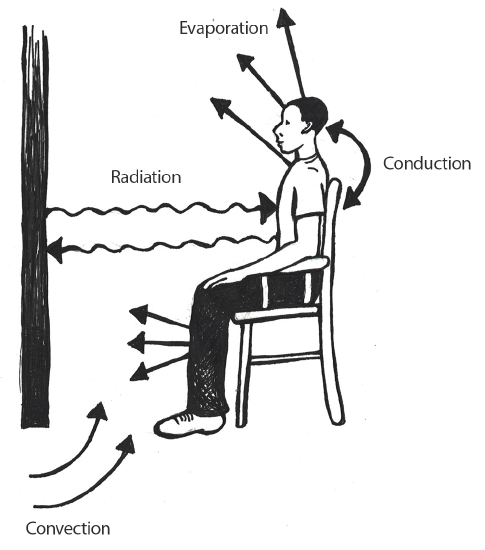 Figure \(\PageIndex{2}\): Various thermodynamic mechanisms related to heat gain and loss in the human body.
Figure \(\PageIndex{2}\): Various thermodynamic mechanisms related to heat gain and loss in the human body.Before we discuss how varying ambient temperatures affect the human body, we must detail the thermodynamic mechanisms through which heat may be gained or lost. There are four pathways for the loss of heat within the human body: conduction, convection, evaporation, and radiation (Figure \(\PageIndex{2}\)).
Through conduction processes, heat will move from a warmer body to a cooler one through direct contact. An example of this is when you accidentally touch a hot cooktop with your hand and the heat is transferred from the cooktop to your skin.
With convection, when a warm body is surrounded by a cooler fluid (e.g. air or water) heat will be transferred from the warmer body to the cooler fluid. This is why we will often employ the behavioral adjustment of wearing multiple layers of clothing during the winter in an effort to prevent heat loss to the cooler atmosphere. Conversely, if your body temperature is cooler than that of the air surrounding you, your body will absorb heat.
Mechanism of heat transfer between objects through direct contact.
Movement of heat away from a warm object to the cooler surrounding fluid (i.e., gas or liquid).
Depending on your physical condition, most people will begin to sweat around 37.2℃ to 37.7℃ (98.9℉ – 99.9℉). Sweating is an example of evaporation, which occurs when a liquid, such as the water within our bodies, is converted to a gas. Phase conversions, such as those underlying the evaporative processes of transforming liquids to gases, require energy. In evaporation, this energy is in the form of heat, and the effect is to cool the body.
The final mechanism for heat loss within the human body is radiation, through which energy in the form of electromagnetic waves is produced at a wavelength that typically lies below that which is visible to the human eye. Although humans gain and lose heat from their bodies through radiation, this form of heat transfer is not visible. Humans are capable of losing and gaining heat through conduction, convection, and radiation; however, heat may not be gained through evaporation.
Mechanism of heat transfer where liquid is transformed into a gas utilizing energy (e.g., heat).
Mechanism of heat transfer involving electromagnetic energy being emitted from an object.
As the ambient temperature decreases, it becomes increasingly difficult for the human body to regulate its core temperature, which is central to the maintenance of homeostasis. The hypothalamus is a small portion of the human brain located near its base. It is responsible for numerous functions, including the regulation of body temperature. As measured orally, normal human body temperature averages 37℃ (98.6°F). When an individual’s body temperature falls below 34.4℃ (93.9°F), the hypothalamus becomes impaired leading to issues with body temperature control. A total loss of the ability to regulate body temperature occurs around 29.4℃ (84.9°F), which may result in death. When the ambient temperature (e.g. air temperature) falls below the critical temperature of 31℃ (87.8°F), a nude human body that is at rest will respond with a series of physiological changes to preserve homeostasis (Figure \(\PageIndex{3}\)).
Small portion of the human brain responsible for body temperature regulation.
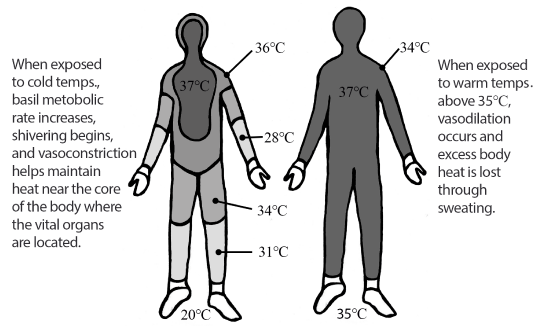 Figure \(\PageIndex{3}\): Example of overall body heat maintenance in cold and warm ambient environments.
Figure \(\PageIndex{3}\): Example of overall body heat maintenance in cold and warm ambient environments.In response to colder temperatures, the human body experiences two main types of physiological responses: those that increase the production of heat within the body and those that seek to retain the body’s heat. The production of heat within the body is accomplished through short-term increases in the body’s basal metabolic rate. This rate is a measure of the energy required to maintain necessary body processes while the body is in a resting state. As the body’s basal metabolic rate increases, an individual must consume greater quantities of energy-providing nutrients to maintain the increase. Of course, such increases may not continue forever as they are energetically expensive. As with all acclimatory adjustments, an increase in the basal metabolic rate is merely temporary.
Another form of a temporary heat-generating acclimatory adjustment to cold stress is the physiological response of shivering. Shivering results when the hypothalamus stimulates increased muscular activity that leads to an elevation of the muscular metabolism. Much like the increased muscular metabolism that occurs during periods of strenuous exercise, the elevation of muscular metabolism rates during shivering leads to higher rates of body heat generation.
Other physiological mechanisms the body uses to assist with the maintenance of temperature related to homeostasis involve the preservation of heat already contained within the body. Of these mechanisms, the most notable is the constriction of peripheral capillaries in the skin through a process called vasoconstriction. The decreased surface area of the capillaries through vasoconstriction results in less heat reaching the surface of the skin where it would be dissipated into the atmosphere. In addition, vasoconstriction leads to the maintenance of heat near the core of the body where the vital organs are located. This is one of the reasons that an individual may experience cold-related injuries, such as frost-bite leading to tissue necrosis (tissue death) in regions of the body that are most distant from the core (e.g. fingers, toes, nose, ears, cheeks, chin, etc.).
Narrowing of the blood vessels due to contractions of the muscular vessel walls.
Just as cold stress presents challenges to maintaining homeostasis within the body with respect to temperature, heat does as well. In hot climates, the body will begin to absorb extra heat from its surroundings (through conduction, convection, and radiation) resulting in potential heat-related disorders, such as heat exhaustion. When the human body is exposed to ambient temperatures above 35℃ (95°F), excess body heat will be lost primarily through evaporative processes, specifically through sweating. All humans, regardless of their environment, have approximately the same number of sweat glands within their bodies. Over time, individuals living in hot, arid environments will develop more sensitive forms of sweat glands resulting in the production of greater quantities of sweat. In an effort to prevent dehydration due to this form of acclimatory adjustment, there will be an additional reduction in the volume of urine produced by the individual.
As noted in the previous section, some cultural groups, particularly those in equatorial regions, add pungent spices to their foods to inhibit the colonization of bacteria (Sherman and Billing 1999). Although the addition of spices to foods to decrease spoilage rates is a behavioral adjustment, the application of some forms of peppers triggers an acclimatory adjustment process as well. Compounds referred to as capsaicinoids are the secondary byproducts of chili pepper plants’ metabolism. Capsaicinoids are produced by the plants to deter their consumption by some forms of fungi and mammals. When mammals, such as humans, consume the capsaicinoids from chili peppers, a burning sensation may occur within their mouths and along their digestive tracts. This burning sensation is the result of the activation of capsaicin receptors along the body’s nerve pathways. Although the peppers themselves may be at ambient temperature so their consumption is technically not causing any form of body temperature increase, the human body perceives the pepper as elevating its core temperature due to the activation of the capsaicin receptors. Even though the body’s temperature has not actually been elevated due to the consumption of capsaicin, the hypothalamus will react as if it has, which leads to the initiation of sweating processes in an attempt to lower body temperature and maintain homeostasis. The increased piquancy (application of pungent spices to food) as a means of inhibiting food-borne bacterial colonization in warm climates, as well as spices’ ability to trigger sweating processes as a method for cooling the body, is an example of the intersection between behavioral and acclimatory adjustments that may be utilized by individuals within certain populations.
In addition to increased sweat production in the body as a means of regulating internal body temperature to maintain homeostasis, vasodilation may occur (Figure \(\PageIndex{4}\)). Vasodilation occurs when there is an expansion of the capillaries within the skin leading to a more effective transfer of heat from within the body to the exterior to allow conductive, convective, radiative, and evaporative (sweating) processes to occur.
Dilation of the blood vessels due to relaxation of the muscular vessel walls.
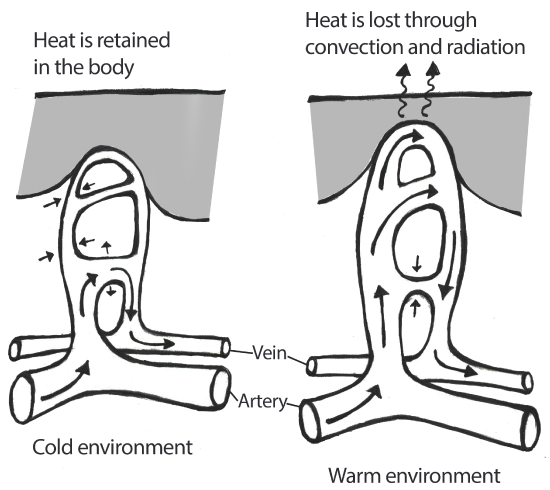 Figure \(\PageIndex{4}\): This image features an illustration of the vasoconstriction processes that occur within the peripheral vascular system when an individual is exposed to cold ambient temperatures and the vasodilation that occurs in warmer environments.
Figure \(\PageIndex{4}\): This image features an illustration of the vasoconstriction processes that occur within the peripheral vascular system when an individual is exposed to cold ambient temperatures and the vasodilation that occurs in warmer environments.Physiologically-based acclimatory adjustments to hot, dry climates may be complemented by behavioral adjustments as well. For example, individuals in such climates may limit their physical activity during the times of day when the temperature is typically the hottest. Additionally, these individuals may wear loose-fitting clothing that covers much of their skin. The looseness of the clothing allows for air to flow between the clothing and the skin to permit the effective evaporation of sweat. Although it may seem counterintuitive to cover one’s body completely in a hot climate, the covering of the skin keeps the sun’s rays from directly penetrating the skin and elevating the body’s core temperature.
Acclimatory Adjustments: Altitudinal Stressors
The challenges posed by thermal conditions are but one form of environmental stressor humans must face. High-altitude environments, which are defined as altitudes in excess of 2400 meters above sea level (m.a.s.l.) or 7874 feet above sea level (f.a.s.l.), pose additional challenges to the maintenance of homeostasis in humans. Some of the main stressors encountered by those living within high-altitude environments include: decreased oxygen availability, cold temperatures, low humidity, high wind speed, a reduced nutritional base, and increased solar radiation levels. Of these challenges, the most significant is the decreased availability of oxygen.
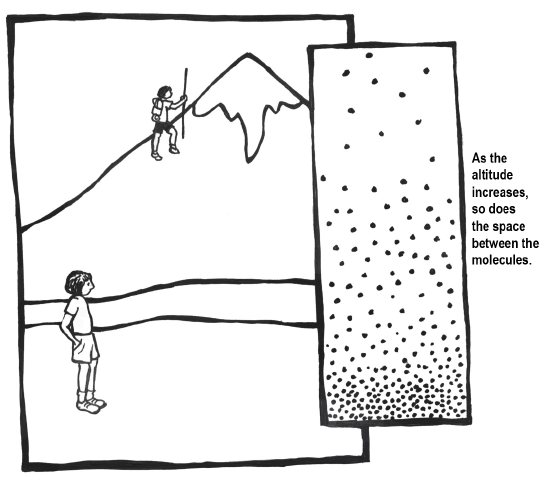 Figure \(\PageIndex{5}\): As altitude increases, atmospheric pressure decreases, which allows for more space between air molecules.
Figure \(\PageIndex{5}\): As altitude increases, atmospheric pressure decreases, which allows for more space between air molecules.To visualize how altitude affects the availability of oxygen, imagine two balloons that are each filled with the same quantity of oxygen molecules. One of these balloons is positioned at sea-level and the other is placed high upon a mountain peak. For the balloon at sea level, there is more atmospheric pressure pressing down on the molecules within this balloon. This leads to the oxygen molecules within the sea level balloon being forced into a more compact organization. In contrast, the mountain peak balloon has less atmospheric pressure pressing down on it. This leads to the oxygen molecules within that balloon spreading out from each other since they are not being forced together quite as strongly. This example highlights the availability of oxygen molecules in each breath than we take in low- versus high-altitude environments. At 5,500 m.a.s.l. (approximately 18,000 f.a.s.l.), the atmospheric pressure is approximately 50% of its value at sea level (Peacock 1998). At the peak of Mount Everest (8,900 m.a.s.l. or approximately 29,200 f.a.s.l.), the atmospheric pressure is equivalent to only about 30% of their sea level amounts (Peacock 1998) (Figure \(\PageIndex{5}\)).
Due to the decreased availability of oxygen at higher altitudes, certain acclimatory adjustments are required to ensure the maintenance of homeostasis for individuals other than those who were gestated, born, and raised at high altitude. For these people, their rate of breathing will increase to permit greater quantities of air containing oxygen into the lungs when they ascend into higher altitude environments. An increased speed and depth of breathing, which is referred to as hyperpnea, is not sustainable indefinitely; thus, the rate of breathing begins to decrease as the person becomes acclimatized to the altitude. During the initial phases of high-altitude-related hyperpnea, the heart will begin to beat faster but the stroke volume (the amount of blood pushed through during each beat) will decrease slightly. In addition, the body will divert energy from non-critical bodily functions, such as digestive processes.
Increased depth and rate of respiration.
Once the atmospheric oxygen reaches the alveoli (small air sacs) in the lungs, it diffuses (spreads) across the alveolar membrane and enters erythrocytes (red blood cells). When the oxygen reaches the erythrocytes, it will loosely bind with hemoglobin, which is an iron-rich protein. It is within the alveoli that the oxygen combines with the hemoglobin. When the erythrocytes carrying the hemoglobin-binded oxygen molecules reach the capillaries where the partial pressure of oxygen is relatively low, the oxygen will be released by the hemoglobin so that it is free for diffusion into body cells. High-altitude-related hyperpnea leads to an increase in the pH of the blood, which makes the blood more alkaline. An increase in the alkalinity of blood is directly related to the partial pressures of oxygen and carbon dioxide in the bloodstream (Shah et al. 2006).
Red blood cell; most common form of blood cell—principle means of transporting oxygen throughout the circulatory system.
Similar to the acclimatory adjustments related to thermal conditions (e.g., shivering or sweating), those related to high altitude may not be sustained permanently due to their energetically expensive nature. Over a period of days or weeks, the human body will begin to compensate for the increases in respiration as well as pH through the urinary excretion of bicarbonate (a metabolic byproduct). In addition, to assist with the transportation of oxygen in the absence of decreased respiration, there will be an increase in the following: hematocrit (percentage volume of erythrocytes in the blood), myoglobin (oxygen- and iron-binding protein in muscle tissues), red blood cell mass, pulmonary artery pressure, and quantity of capillaries in the skeletal muscular tissue.
Volume percentage of red blood cells within the blood.
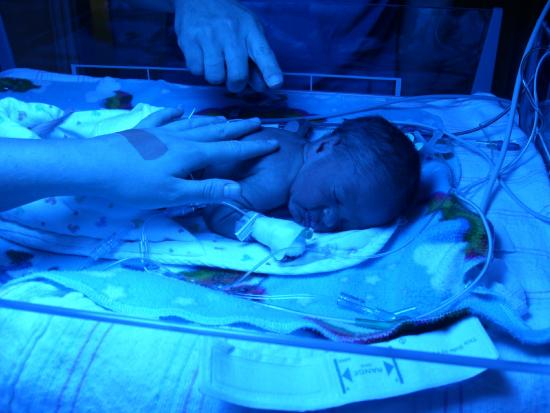 Figure \(\PageIndex{6}\): Premature infant born at 30 weeks, 4 days gestation to a mother with altitudinal-induced preeclampsia. Blue light assists the infant’s liver with processing high levels of bilirubin.
Figure \(\PageIndex{6}\): Premature infant born at 30 weeks, 4 days gestation to a mother with altitudinal-induced preeclampsia. Blue light assists the infant’s liver with processing high levels of bilirubin.Although the long-term acclimatory adjustments that an individual from low altitude experiences in a high-altitude environment may permit them to reside there successfully, reproduction within such settings is frequently complicated. With increased altitude comes an increased risk of miscarriage, lower birth weights, and higher infant mortality rates. As the mother’s body seeks to preserve its own homeostasis when faced with challenges related to high-altitude living, there is often a decreased rate and volume of blood flow to the uterus as compared to a pregnant woman of similar physiological condition at a lower altitude (Moore et al. 1998). Of course, a decreased rate and volume of uterine blood flow results in a decrease in the amount of oxygen that will be passed through the uterus and placenta to the developing fetus. In addition, women who experience pregnancy at higher altitudes are more prone to developing preeclampsia (severe elevation of blood pressure), which is linked to increased rates of both fetal and maternal death (Moore et al. 1998) (Figure \(\PageIndex{6}\)).
Developmental Adjustments
Although there are often significant challenges for a mother gestating a fetus at high altitude, individuals who are native to such environments experience a form of adjustment referred to as a developmental adjustment. Developmental adjustments occur only in individuals who spent their developmental period (i.e. childhood and adolescence) within a high-altitude environment and they do not apply to those who moved into these environments in the post-developmental (i.e., adult) phase. Furthermore, the degree of developmental adjustment within an individual is directly related to their underlying phenotypic plasticity (polyphenism) as well as the amount of time during the crucial growth and development period the individual resides within the challenging environment. Although humans have the remarkable capacity to develop and survive within environments that are not overly conducive to the successful maintenance of homeostasis, there are definitely physiological costs associated with this ability.
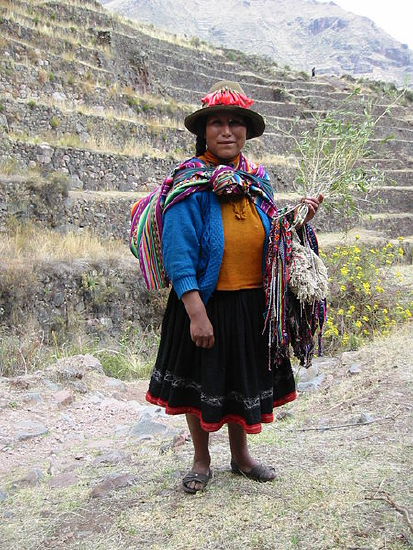 Figure \(\PageIndex{7}\): Quechua woman from high-altitude region of the Peruvian Andes.
Figure \(\PageIndex{7}\): Quechua woman from high-altitude region of the Peruvian Andes.In general, high-altitude natives tend to grow more slowly and physically mature later than their low-altitude counterparts (Figure \(\PageIndex{7}\) ). Decreased growth and maturity rates are linked not only to the increased physiological demands placed on the body due to the decreased partial pressure of oxygen but to decreases in the quality of the nutritional base at higher altitudes. Increased terrain complexity, elevated solar radiation levels, and higher wind speeds coupled with decreased temperatures and lower humidity levels at higher altitudes leads to difficulties with growing and maintaining crops and raising livestock. Overall, there is a decreased quality in the available nutritional base as altitude increases, which is correlated to a lack of the nutrients necessary to ensure proper physiological growth and development in humans. Thus, even though individuals may be able to develop and grow within high-altitude environments, they may not reach their full genetically mediated growth potential as they would in a lower-altitude environment.
The heart and lung capacity of individuals who are lifelong residents of high-altitude environments is larger than for individuals from lower-altitude regions. In addition, the high-altitude individuals are more efficient than those from low altitudes at diffusing oxygen from the bloodstream to the body’s various tissues. Of course, as noted previously, the developmental adjustments that an individual may experience are defined by their underlying genetic composition (phenotypic plasticity) and researchers have begun to discover some of the genetic factors that appear to be unique to certain populations of humans who have resided in high-altitude environments for significant periods of time. The time frame necessary for natural selection processes to act upon the underlying genetic composition of a population is on the order of many millennia; thus, the physiological changes to indigenous high-altitude populations on a whole are best described in the following section on adaptations.
Not all developmental adjustments are linked to environmental pressures such as climate or altitude; rather, some of these adjustments are correlated to sociocultural or behavioral practices. As noted earlier, some behavioral adjustments permit individuals to maintain homeostasis in challenging environments (e.g., wearing heavy clothing layers to maintain body temperature in cold weather). Other behavioral adjustments, many of which are based on sociocultural principles, may affect the physiological appearance of an individual when they are practiced consistently during the development and growth phases.
Sudden infant death syndrome (SIDS) has no definitive cause; however, the American Academy of Pediatrics published a report in 1992 linking SIDS to infants (under the age of one) sleeping on their stomachs. The “Back to Sleep” campaign championed by the American Academy of Pediatrics helped educate members of the medical community as well as the public that the best sleep position for infants is on their backs. Per the American Academy of Pediatrics Task Force on Infant Sleep Position and Sudden Infant Death Syndrome (2000: 1,245), between 1992 and 2000 the frequency of infants being placed on their stomachs to sleep decreased from more than 70% to less than 20% and the SIDS rate decreased by more than 40%.
 Figure \(\PageIndex{8}\): Infant with positional plagiocephaly. Notice the irregular shape of the posterior (back) of the skull.
Figure \(\PageIndex{8}\): Infant with positional plagiocephaly. Notice the irregular shape of the posterior (back) of the skull.Placing infants on their backs to sleep has led to decreased infant mortality (death) rates due to SIDS; however, it has led to an unintended consequence: infant cranial deformation. The cranial deformations experienced by infants who sleep solely on their back tend to manifest in one of two forms: brachycephaly and plagiocephaly (Roby et al. 2012). With positional brachycephaly, the back of the infant’s head appears rather uniformly flattened due to repetitive contact with a flat surface, such as a crib mattress or car seat back. In cases of positional plagiocephaly, the back of the infant’s head appears asymmetrically flattened (Figure \(\PageIndex{8}\) ). This asymmetry is typically due to an uneven distribution of mechanical forces resulting from the manner in which the infant’s head is in contact with a flat surface. The forms of cranial deformation resulting from sleep positioning do not affect the infant’s brain development. For many individuals, the appearance of the deformation is minimized during later development. Still, some individuals will maintain the pattern of cranial deformation acquired during their infancy throughout their lives. The unintentional cranial deformation resulting from placing infants on their backs to sleep as a means of preventing SIDS-related deaths is a physiological indicator of a behavioral adjustment.
REFERENCES
American Academy of Pediatrics, Task Force on Infant Sleep Position and Sudden Infant Death Syndrome. 2000. “Changing concepts of sudden infant death syndrome: implications for infant sleeping environment and sleep position.” Pediatrics 105: 650–656, 116 (5): 1,245.
Moore, Lorna G, Susan Niermeyer, and Stacy Zamudio. 1998. “Human Adaptation to High Altitude: Regional and Life-Cycle Perspectives.” Yearbook of Physical Anthropology 41: 25–64.
Peacock, A. J. 1998. “ABC of Oxygen: Oxygen at High Altitude.” BMJ 317 (7,165): 1,063–1,066.
Roby, Brianne Barnett, Marsha Finkelstein, Robert J. Tibesar, and James D. Sidman. 2012. “Prevalence of Positional Plagiocephaly in Teens Born after the ‘Back to Sleep’ Campaign.” Otolaryngology—Head and Neck Surgery 146 (5): 823–828.
Shah, Mark B., Darren Braude, Cameron S. Crandall, Heemun Kwack, Lisa Rabinowitz, Thomas A. Cumbo, Buddha Basnyat, and Govin Bhasyall. 2006. “Changes in Metabolic and Hematologic Laboratory Values With Ascent to Altitude and the Development of Acute Mountain Sickness in Nepalese Pilgrims.” Wilderness and Environmental Medicine 17 (3): 171–177.
Sherman, Paul W., and Jennifer Billing. 1999. “Darwinian Gastronomy: Why We Use Spices.” BioScience 49 (6): 453–463.
FIGURE ATTRIBUTIONS
Figure \(\PageIndex{1}\) Deep water diver by Leslie E. Fitzpatrick is under a CC BY-NC 4.0 License.
Figure \(\PageIndex{2}\) Mechanisms of heat transfer original to Explorations: An Open Invitation to Biological Anthropology by Mary Nelson is under a CC BY-NC 4.0 License.
Figure \(\PageIndex{3}\) Body heat maintenance in cold and warm original to Explorations: An Open Invitation to Biological Anthropology by Mary Nelson is under a CC BY-NC 4.0 License.
Figure \(\PageIndex{4}\) Vasoconstriction and vasodilation original to Explorations: An Open Invitation to Biological Anthropology by Mary Nelson is under a CC BY-NC 4.0 License.
Figure \(\PageIndex{5}\) Atmospheric pressure original to Explorations: An Open Invitation to Biological Anthropology by Mary Nelson is under a CC BY-NC 4.0 License.
Figure \(\PageIndex{6}\) Premature infant by Leslie E. Fitzpatrick is under a CC BY-NC 4.0 License.
Figure \(\PageIndex{7}\) Quechua Woman in Peru by Alexander Fiebrandt (Alecconnell at de.Wikipedia) is under a CC BY-SA 2.0 DE License.
Figure \(\PageIndex{8}\) Плагиоцефалия (Plagiocephaly) by Medical advises at larece.ru/?p=27115 is under a CC BY-SA 3.0 License.

